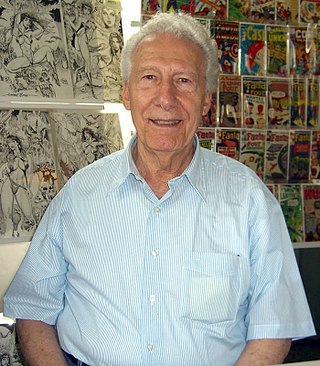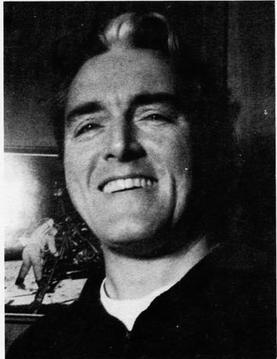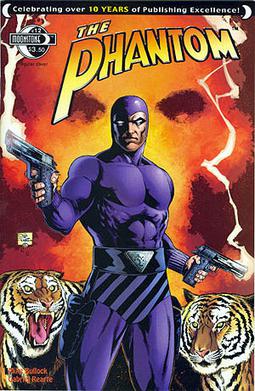
Flash Gordon is the protagonist of a space adventure comic strip created and originally drawn by Alex Raymond. First published January 7, 1934, the strip was inspired by, and created to compete with, the already established Buck Rogers adventure strip.

The Phantom is an American adventure comic strip, first published by Lee Falk in February 1936. The main character, the Phantom, is a fictional costumed crime-fighter who operates from the fictional African country of Bangalla. The character has been adapted for television, film and video games.

King Features Syndicate, Inc. is an American content distribution and animation studio, consumer product licensing and print syndication company owned by Hearst Communications that distributes about 150 comic strips, newspaper columns, editorial cartoons, puzzles, and games to nearly 5,000 newspapers worldwide. King Features Syndicate also produces intellectual properties, develops new content and franchises, like The Cuphead Show!, which it produced with Netflix, and licenses its classic characters and properties.
Frank W. Bolle was an American comic-strip artist, comic book artist and illustrator, best known as the longtime artist of the newspaper strips Winnie Winkle and The Heart of Juliet Jones; for stints on the comic books Tim Holt and Doctor Solar, Man of the Atom; and as an illustrator for the Boy Scouts of America magazine Boys' Life for 18 years. With an unknown writer, he co-created the masked, Old West comic-book heroine the Black Phantom. Bolle sometimes used the pen name FWB and, at least once, F. L. Blake.

Alfonso Williamson was an American cartoonist, comic book artist and illustrator specializing in adventure, Western, science fiction and fantasy.
Daniel Barry was an American cartoonist. Beginning in comic books during the 1940s with Leonard Starr, Stan Drake and his brother Sy Barry, he helped define and exemplify a particular kind of "New York Slick" style which dominated comics until the Marvel Revolution brought attention to the Jack Kirby style. This style was characterized by careful attention to lines and the clear delineation of textures.

Graham Nolan is an American comic book artist, best known for work for DC Comics on Batman-related titles in the 1990s and his work on The Phantom Sunday strip. He frequently collaborates with writer Chuck Dixon.

Michael Manley is an American artist, most notable as a comic strip cartoonist and comic book inker and penciller. Manley currently draws two syndicated comic strips, Judge Parker and The Phantom. He is also known for co-creating the Marvel Comics character Darkhawk.

George Roussos, also known under the pseudonym George Bell, was an American comic book artist best known as one of Jack Kirby's Silver Age inkers, including on landmark early issues of Marvel Comics' Fantastic Four. Over five decades, he created artwork for numerous publishers, including EC Comics, and he was a staff colorist for Marvel Comics.

Joe Giella was an American comic book artist best known as a DC Comics inker during the late 1950s and 1960s period which historians and fans call the Silver Age of Comic Books. Due to his long and prolific career, Giella has been described as "one of the creators synonymous with the Silver Age of Comics."
"Charles Nicholas" is the pseudonymous house name of three early creators of American comic books for the Fox Feature Syndicate and Fox Comics: Chuck Cuidera (1915–2001), Jack Kirby (1917–1994), and Charles Wojtkoski (1921–1985). The name originated at Eisner & Iger, one of the first comic book packagers that created comics on demand for publishers entering the new medium during the 1930s–1940s Golden Age of comic books. The three creators are listed in order of birth year, below.

Fred Kida was a Japanese-American comic book and comic strip artist best known for the 1940s aviator hero Airboy and his antagonist and sometime ally Valkyrie during the period fans and historians call the Golden Age of Comic Books. He went on to draw for Marvel Comics' 1950s iteration, Atlas Comics, in a variety of genres and styles, and then again for Marvel superhero titles in the 1970s. He drew the company's The Amazing Spider-Man newspaper comic strip during the early to mid-1980s. Kida also assisted artist Dan Barry on the long-running strip Flash Gordon from 1958 to 1961 and then again from 1968 to 1971.

Frank Springer was an American comics artist best known for Marvel Comics' Dazzler and Nick Fury, Agent of S.H.I.E.L.D.. As well, in collaboration with writer Michael O'Donoghue, Springer created one of the first adult-oriented comics features on American newsstands: "The Adventures of Phoebe Zeit-Geist" in the magazine Evergreen Review. A multiple winner of the National Cartoonists Society's Reuben Award, Springer was a president of the Society and a founding member of the Berndt Toast Gang, its Long Island chapter.

Robert Wilson McCoy was an American illustrator and painter, best known as the second artist on The Phantom comic strip. He always went by his middle name and signed The Phantom as Wilson McCoy, but his other artwork was signed R. Wilson McCoy.

Jay Malcolm Kennedy was an American editor and writer. The author of The Official Underground and Newave Comix Price Guide, he was a long-time editor at King Features Syndicate, eventually rising to the position of editor-in-chief.
Paul Ryan was an American comic artist. Ryan worked extensively for Marvel Comics and DC Comics on a number of super-hero comic book titles. He is best known for his 1991 to 1996 run as penciler on Fantastic Four, which represents his longest association with an individual comic book series. From 2005 until his death in 2016, Ryan penciled and inked the daily newspaper comic strip The Phantom for King Features Syndicate.

Frederick Whitney Ellsworth was an American comic book editor and sometime writer and artist for DC Comics during the period known to historians and fans as the Golden Age of Comic Books. He was also DC's "movie studio contact", becoming both a producer and story editor on the TV series The Adventures of Superman.

The Phantom is a fictional costumed crime-fighter who operates from the fictional country of Bangalla originally Bengali. The character was created by Lee Falk for the adventure comic strip The Phantom, which debuted in newspapers on February 17, 1936.
Carl T. Pfeufer was an American comic-book artist, magazine illustrator, painter, and sculptor. He was an early contributor to American comic books; one of the primary early artists of the Marvel Comics superhero the Sub-Mariner; and the longtime artist of Western hero Tom Mix's comic books.
Donald Duck is an American comic strip by the Walt Disney Company starring Donald Duck, distributed by King Features Syndicate. The first daily Donald Duck strip debuted in American newspapers on February 7, 1938. On December 10, 1939, the strip expanded to a Sunday page as well. Writer Bob Karp and artist Al Taliaferro worked together on the strip for more than 30 years. The strip ended in May 1995.













